San Francisco is considered one of America’s most charming and most beautiful metropolitan cities, and when you are there you immediately understand why. Besides the location, there are countless sights and things to do in both the city itself and in the beautiful scenery that surrounds the Californian city.
There are some landmarks and famous places you probably already know before coming to San Francisco. The hills and steep streets, the city’s cable cars, Alcatraz prison island and, not least, the Golden Gate Bridge are some of the highlights which have been seen in countless Hollywood movies, on photos and postcards and so on.
Architecture, museums and beautiful parks and nature are things you will enjoy here. The Financial District and the Civic Center are the absolute centers of the city, and popular Pier 39 and Fisherman’s Wharf are sights close by. The best way to go from place to place is by foot or with the iconic cable cars or the vintage tram line F. Between it all, there are many hills here, and they provide good vantage points to get a look at it all from above.
If you want to make a day trip from San Francisco, you can choose to cross the Golden Gate Bridge and get into the vast nature starting almost at the city limit. California redwoods are a good choice, but your can also get close to nature in the city itself. Green oases such as Golden Gate Park and Presidio are very close by the center of San Francisco. If you want to see another city, Oakland to the east is a possibility. You will be here in a few minutes with the train.
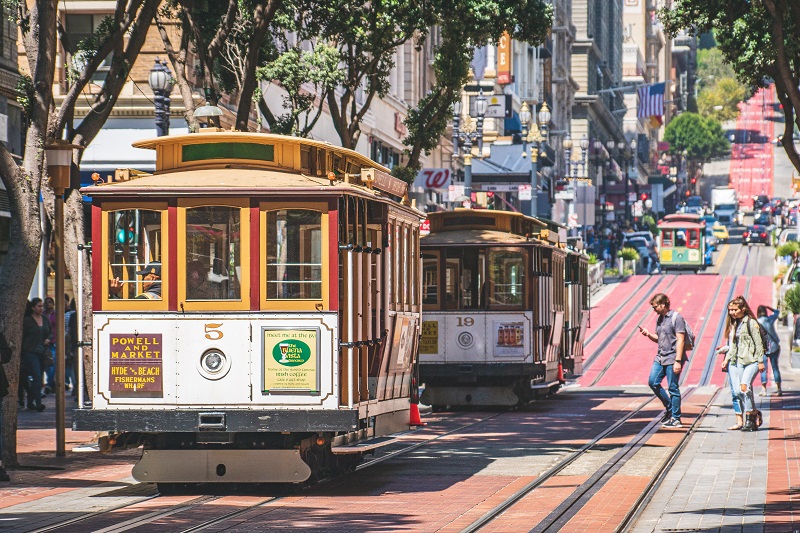
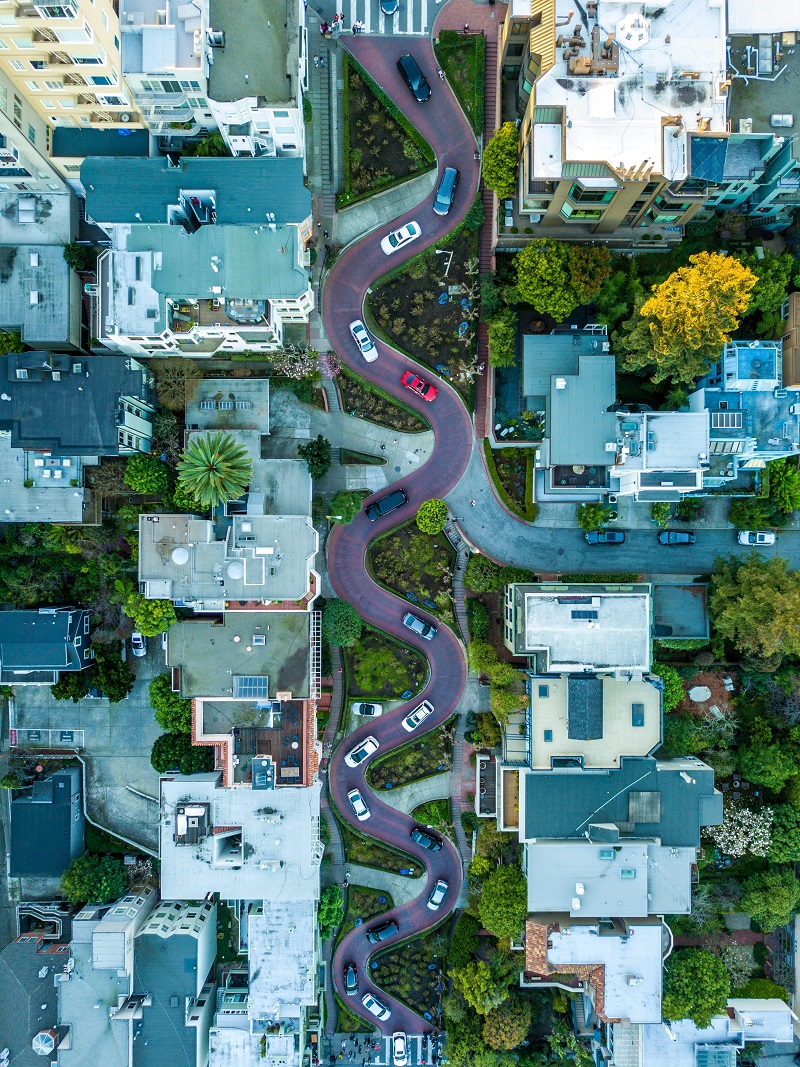
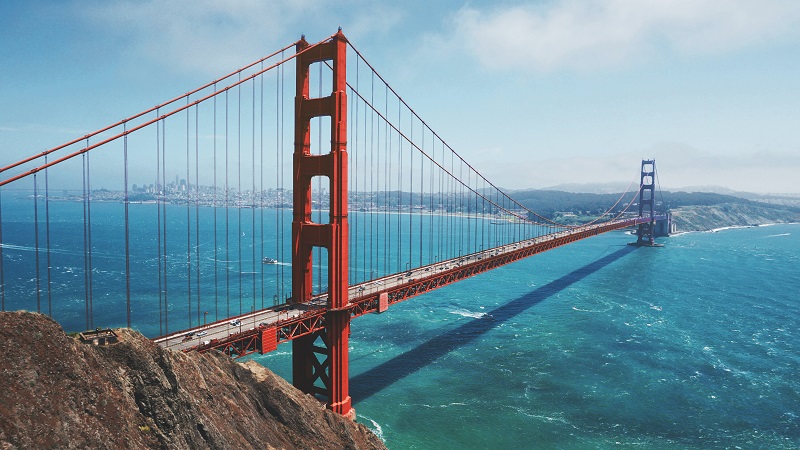
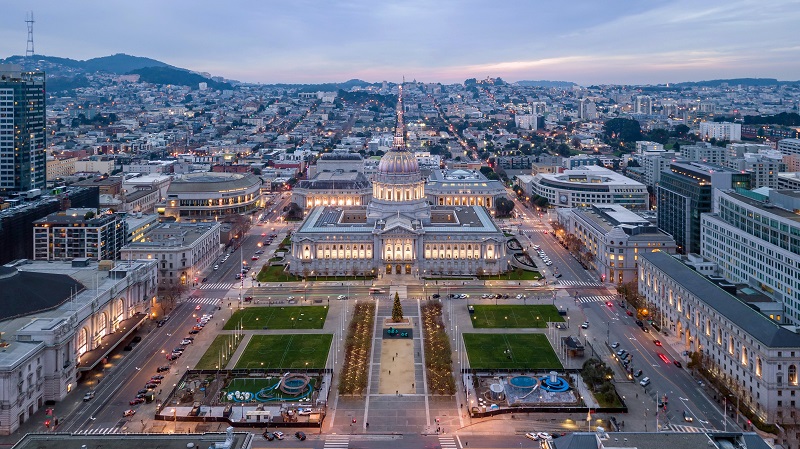

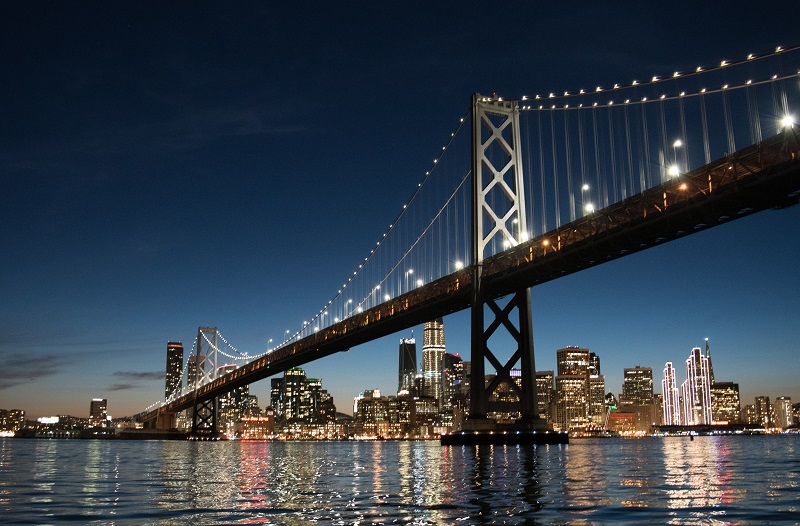
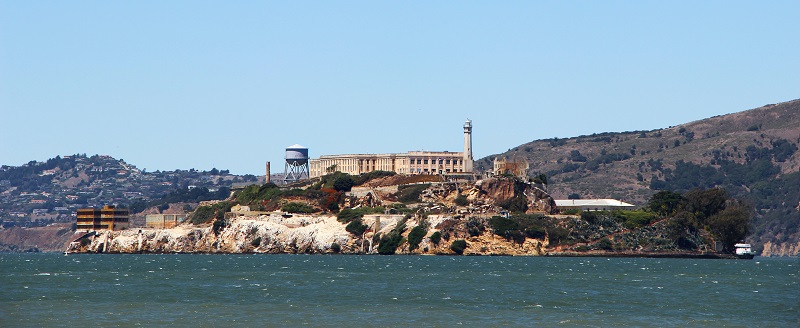
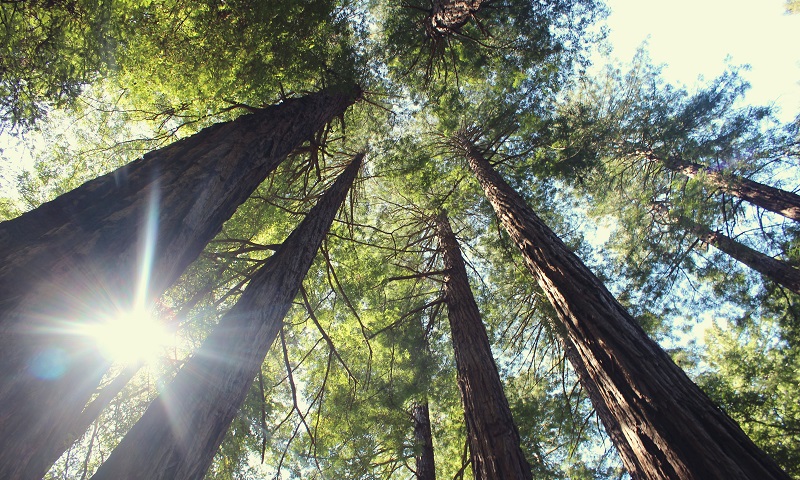
The early settlement
The San Francisco area has been inhabited for thousands of years, and before the European presence, about 10,000 Native Americans are believed to have lived here. The Indians along the west coast were later collectively called the ohlone, the western peoples. However, there were many different tribes represented along the coast.
The tribes originally settled around San Francisco Bay, which was a favorable area for hunting. They later traded with tribes in surrounding areas.
European arrival
The Spaniards came sailing along the California coast to the present San Francisco area in 1542, but on this occasion and through the following centuries no European settlement occurred. Nor did the Spaniards sail into San Francisco Bay, as they sailed past several times due to fog.
Under the leadership of Gaspar de Portolà, the Spaniards in 1769 arrived in the area around the bay, which they proclaimed as Spanish territory under the Viceroy of New Spain. It was on November 2, when the expedition became the first European in the bay off the current metropolis.
The Spaniards noted on the occasion that the bay was a large natural harbor and that the area was thereby strategically important. In 1774, an expedition, with Juan Bautista de Anza, selected places where the military was to be established and where a mission was to be built.
The Presidio was then militarily brought to bear, and Juan Bautista de Anza founded the ecclesiastical Mission Dolores under the original name, Mission San Francisco de Asis. It happened in 1776, and the mission was a leader in cultural building and in converting Indians to Christianity.
Mission Dolores became the starting point for the area’s European dominance, and for many decades the mission was the center of activity in what later grew into an actual city,
However, access should also be provided from the sea side, which is why the first anchorages were established. It happened in the area of present-day Lower Market Street, which since the time of Anzas has turned into land.
Businessmen from several countries
The Spaniards were the ones who colonized California, but Spain was not the only nation that had an interest in the American territory.
In 1786, the French Comte de La Pérouse came to San Francisco, which has elaborately described. Six years later it was the British George Vancouver who visited the place; reportedly for information about the Spanish cities in the area.
Russian traders were also very active along the North American west coast. Thus, fur traders from Russia settled and colonized the area from Alaska in the north to California Fort Ross in the south. They did so in the years from 1770 and about 70 years on. In today’s San Francisco, the Russian Hill neighborhood is named after the Russian traders and sailors.
The Mexican city
The Spanish government weakened over the years, and in 1821 the area came under independent Mexico. It was a period when it was not only Spanish Mexicans who made a mark on the city.
The Englishman William Richardson was the one who initiated the propagation of an urban development. In 1835, he first built his house away from the area immediately around Mission Dolores’ location.
Richardson built close to the mission’s anchorage at San Francisco Bay, and along with Francisco de Haro, laid out streets for the further development of the city. At the anchorage, a settlement then emerged and it was called Yerba Buena. The name came from a plant that grew extensively at the site of settlement.
Yerba Buena later became the name of a neighborhood in the city that is today the south of Market, which includes, among other things, Yerba Buena Gardens. The city itself was called San Francisco after the name of the first mission. The city center was a square that today is Portsmouth Square.
By the late 1830s, San Francisco had increasingly become a popular place for American settlers seeking happiness in the west. William Richardson himself got a large piece of land in Marin Country, moving to Rancho Sausalito in 1841. Richardson Bay today bears his name.
Settlers and the United States
In the 1840s, Yerba Buena was still a modest settlement. In the middle of the decade, some 200 people lived, but the population almost doubled when 240 Mormons sailed here to settle in 1846. One of them was Sam Brannan, who later became one of the city’s wealthy people.
The United States had become independent of British rule in the latter half, and the expanding United States came to war with Mexico. It was a war that raged in the years 1846-1847, and during the war, U.S. Navy commander John D. Sloat proclaimed California as U.S. territory.
Sloat proclaimed the American takeover on July 7, 1846, and just two days later several warships USS Portsmouth arrived at Yerba Buena to claim the city. The crew did so by hoisting the American flag in the city’s central square, which was then named Portsmouth Square to commemorate the ship the sailors had brought.
Second Lieutenant Henry Bull’s Watson became the head of the United States garrison, and Lieutenant Washington A. Bartlett became the head of the city; the so-called alcalde. Bartlett proclaimed that Yerba Buena should change his name to San Francisco, which took effect from January 30, 1847.
San Francisco and the rest of California formally became U.S. territory in 1848 with the Guadalupe Hidalgo Treaty ending the U.S.-Mexico war. California became a state in the United States in 1850.
Gold rush
The desolate land area of the wind-blown peninsula did not have the resources necessary for a major bloom, but it was changed in 1848, where about 1,000 people lived in San Francisco.
That year, the California gold fever started when James W. Marshall found gold at Sutter’s Mill in California Coloma; found only nine days before California became American. The gold find got about 300,000 people seeking happiness by going to California from abroad or from other places in the United States.
The gold diggers were named forty-niners after the year 1849, and it has since become the name of the famous San Francisco 49ers football team. The presence of gold and gold diggers led to new roads being built, churches and schools, and much more in California.
The gold rush caused San Francisco’s population to rise from 1,000 at the beginning of 1848 to 25,000 at the end of 1849. Growth continued through the 1850s, and it gained new sustenance following the publication of the silver find at Mount Davidson in western Utah’s then-Territory in 1859. People stormed to, and the port of San Francisco was brimming with growth, ensuring the city’s rapid expansion.
Part of San Francisco’s identity and population composition was founded in the years surrounding the gold fever. The rapid growth in population put pressure on urban planning, resulting in many narrow streets, which continue to characterize the city center today. In addition, a large immigration of Chinese people began to seek work in the mines and in other industries as a result of the gold fever. They became the start of the city’s Chinatown.
Many companies were also founded in connection with the gold fever and the new opportunities following the large population growth. Some examples are the transcontinental railroad where many Chinese worked, Wells Fargo and Levi Strauss & Co.
The gold rush also created some chaos that prevailed in San Francisco as in other mining towns. This was evident in the 1850s when a self-incrimination committee was set up to cleanse the city of corruption and other folly. The committee lynched 12 people and forced officials to resign their positions. It also brought focus to the city’s increasing number of Chinese, and it sparked new unrest due to racial differences, which ended with legislation limiting Chinese immigration from 1882.
The 1850s were a booming period when San Francisco’s high population growth meant that the development had to be forced in a way that sanitary conditions could not follow in the same way as a normal expansion of cities. This meant that cholera from incoming ships could easily spread in both 1850 and 1855. The health system was generally a concern for the state, but due to the cholera epidemics, responsibility for hospitals was transferred to local counties, which is still applicable in California.
Structure and industrialization
Following the widespread chaos of growth and self-sufficiency in the 1850s, the 1860s and the following decades became a period when San Francisco really developed into a truly American metropolis.
The city gained many new neighborhoods in an almost explosive growth. Western Addition, Haight-Ashbury, Eureka Valley and Mission District are the names of some of the new areas that were laid out and built during the decades at the end of the 19th century. The city council also laid out large recreational areas such as Golden Gate Park, which was established in 1887.
Many larger companies had also been founded such as Levi Strauss & Co. and Wells Fargo Bank, locomotives in the city’s industrialization and financial development, strengthened by the city’s stock exchange in 1882. During the same period, the city’s increasing numbers of wealthy people, such as the rail millionaire Leland Stanford, built high-end housing on Nob Hill.
Several institutions were also founded these years. In 1864, surgeon Hugh H. Toland came to San Francisco from South Carolina, and he established Toland Medical College, which later became one of the first three colleges at the University of California at San Francisco. In 1898, the colleges came together as a campus following the decision and donation of land by Mayor Adolph Sutro.
San Francisco’s development and its ever-expanding geographical scope also required an infrastructure that made transportation and logistics easy in the growing city. It was made difficult by the many steep hills on which the city lay, but this problem solved Andrew Smith Hallidie with the construction of the city’s now very famous cable cars, which pulled trams up and down the hills. In total, over time, a large network of lanes was established, connecting many of San Francisco’s neighborhoods.
Culturally, San Francisco was also in the rubble, and well-known authors such as Rudyard Kipling, Mark Twain and Oscar Wilde stayed throughout the years in the city. By the turn of the 20th century, San Francisco had become the United States’ largest city west of Mississippi, and a short transition, it was also the state of California.
Beginning of the 1900s
Around 1900, Mayor James D. Phelan successfully issued bonds that provided San Francisco with funds for important public investment. The money was used, among other things, for a new system of sewers, two parks, a library, a hospital and seventeen new schools.
By the 20th century, the need for greater and more consistent urban planning had become necessary. Not only did James D. Phelan get started in new plants, he also initiated the development of the first major plan for the city’s future. It was a future he saw as a kind of Paris on the Pacific.
In the year 1900, a ship arrived at the port and this had consequences for San Francisco in the following years. The ship had rats on board, which were carriers of bovine plague. The infection spread and ravaged the city until 1904, which was incidentally the first plague epidemic on the American mainland. During the plague, part of Chinatown was quarantined and all burials were banned within the city limits; they were taken to the nearby town of Colma.
City shaken to gravel
On April 18, 1906, San Francisco was hit by an earthquake of 7.8 on the Richter scale. The earthquake was caused by a shake over a 400 km/250 mi stretch of the San Andreas fault from San Juan Bautista to Eureka. The epicenter of the quake was in the water immediately off San Francisco, and the short distance was crucial to the tremendous devastation of the city.
The earthquake tore many of San Francisco’s water lines, and fires started in countless places in the city. The fires raged uncontrollably for days and a total of about 80% of the city was completely destroyed; among other things, pretty much the entire center. Many of the city’s residents were caught between the fires and the water in San Francisco Bay, and a major evacuation was initiated over just the bay’s water. Several camps were also set up in which shelters could live as refugees after their homes were destroyed.
The official death toll for the earthquake was set at 478; in 2005, the figure was corrected to more than 3,000 dead. The low figure of 1906 is thought to be due to the attempt to keep people’s morale as high as possible in the huge reconstruction work that was underway.
Similarly, the city of San Francisco’s reputation as a growth city with good investment opportunities should be preserved in the rest of the United States. This consideration made it possible, among other things, to beautify mailboxes and pictures in the time after the earthquake, which often looked as if the most important buildings and institutions were still intact in San Francisco.
The Great Reconstruction
The April 18, 1906 earthquake was the most devastating natural disaster in California’s inhabited history, and with 80% of the city in gravel, a huge rebuilding effort needed to get San Francisco back on track.
One of the most ambitious plans emerged town planner Daniel Burnham. His vision for San Francisco included a number of boulevards and radial streets with Haussmann’s Paris as an example. He also presented thoughts on a large Civic Center and a number of other projects for the city.
Burnham’s project was not approved, believing it was not feasible to implement. Many landowners were also opposed to the proposal because it required large public land purchases to establish the many roads and facilities. However, several elements of Burnham’s vision were implemented in the rebuilding of San Francisco.
For example, a large Civic Center was established with the town hall as the center, and many streets were widened, even though the street network from before the earthquake was reused. Burnham’s proposal for a lane under Market Street and a monument on Telegraph Hill also saw the light of day.
In the reconstruction years after the 1906 earthquake, a proposal from the city of San Francisco also emerged to create a kind of Great San Francisco with the cities around San Francisco Bay. In the proposal, central San Francisco would act as Manhattan in New York City. The proposal was voted down several times so that San Francisco’s city limits were fixed.
The reconstruction went so strong that as early as 1915, the city hosted the Great American Exhibition celebrating the opening of the Panama Canal; Panama-Pacific International Exposition. The exhibit was important to San Francisco, thereby being able to show the world that the city was again as in its former greatness.
After the exhibition, the exhibition buildings were all destroyed except for the Palace of Fine Arts, which was demolished and rebuilt with modifications to the original design. The area where the exhibit was located was developed into the Marina District.
San Francisco had, through the great reconstruction of countless new buildings, created the foundation for another period of prosperity, but the United States, like other parts of the world, faced tougher economic times from 1929 and through the depression in the 1930s.
Depression, bridges and world war
1930s were characterized by mass unemployment and economic decline compared to 1920’s recovery. Large public construction projects were initiated in many parts of the country to restore the economy and to create jobs.
In San Francisco, construction workers went hand in hand with the city’s further development. The isolated position of the city on the peninsula between the Pacific and San Francisco Bay was broken in 1936 and 1937 when the Oakland Bay Bridge and the Golden Gate Bridge were opened, respectively. The colossal bridges tied the entire San Francisco Bay area together in a new way, replacing ferry traffic and long drives around the bay.
Another international exhibition was also held in San Francisco in the 1930s. It was the Golden Gate International Exposition in 1939, which could be visited on Treasure Island. It was also during this time that the military facility on the island of Alcatraz was set up as a high security prison. It came to house prisoners like Al Capone and Robert Franklin Stroud, known as The Birdman of Alcatraz. He was given that nickname because during his stay in Leavenworth prison, he saved injured sparrows and then devoted much of his time to bird breeding.
During World War II, San Francisco was a major supply and shipping port during the Pacific War between the United States and Japan. A later very well known shipment was shipped with the USS Indianapolis in January 1945; these were components of the first atomic bomb going to Tinian.
The Pacific War against Japan was also of great importance in a very direct way to some of San Francisco’s inhabitants. In the Japantown district, the largest Japanese population lived outside Japan itself. As a result of the provision called Executive Order 9066, all residents of Japan or of Japanese descent in the United States were interned.
With the forced internment of the Japanese, a significant portion of Japantown was left uninhabited, and it exploited many black immigrants who came from the southern states of the United States to find jobs in California. The blacks moved into both Japantown and other areas, and the migration changed the composition of the city’s population.
In the aftermath of World War II, the United Nations was founded and the founding UN conference was held in San Francisco. The conference was held at the War Memorial Opera House, and on June 26, 1945, the UN Charter was signed at the city’s Herbst Theater. The Pacific War was also formally ended in San Francisco. It came with the signing of the San Francisco Treaty in 1951. The treaty ended the paper war and established peaceful relations between the United States and Japan.
Postwar years
During World War II, many American soldiers, officers, and other military personnel had passed through San Francisco on their way to or from the Pacific War. Some of them settled in the city after the war, which in turn expanded; this time with neighborhoods like the Sunset District and Visitacion Valley.
Population density and deployment increased in San Francisco, and it was also a time of improved private economy, with American families increasingly acquiring cars and other consumer goods.
The growth in population has put pressure on San Francisco’s transport system, and many new cars have continuously expanded the road network. The Caltrans company launched a major and comprehensive project to construct highways in the San Francisco Bay area, where land pressure was already underway.
The highway plans became difficult for Caltrans in San Francisco, where new space for new freeways would result in large-scale redevelopment projects and expensive land acquisitions. Therefore, at one point in time, Caltrans began to extend existing highways to highways by building two floors. However, these were not seismically safe, and in 1959 the city council passed a ban on the construction of several highways in the city.
Throughout the 1950s, many neighborhoods with poorer settlements were also sanitized. Mayor George Christopher hired M. Justin Henman to oversee urban development, and Justin Henman started demolishing large areas in, among others, Japantown and Western Addition. Some residents had to move to other neighborhoods on that occasion, and some moved to Oakland on the east coast of San Francisco Bay.
Justin Henman got very new in San Francisco; Embarcadero Center, Yerba Buena Gardens and Embarcadero Freeway are examples of new residential areas. Incidentally, the Embarcadero Freeway directly in front of the Ferry Building has been later demolished to the great delight of many of the city’s inhabitants.
Flowers, hippies, and gays
San Francisco, with its diverse population composition and rapid development, had often been the hub of cultural wrestling, and it happened in the latter half of the 20th century as many countercultures thrived here.
The city became the center of the great and worldwide hippie wave of the 1960s and other alternative cultures. It got rid of the music where the city fostered leading names like Jefferson Airplane and the Grateful Dead.
Later, in the 1980-1990s, the city became the center of the country’s punk and trash metal, and politically, according to American conditions, the city was quite leftist. It was also the time when the city’s reputation as a liberal against g
Overview of San Francisco
San Francisco is considered one of America’s most charming and most beautiful metropolitan cities, and when you are there you immediately understand why. Besides the location, there are countless sights and things to do in both the city itself and in the beautiful scenery that surrounds the Californian city.
There are some landmarks and famous places you probably already know before coming to San Francisco. The hills and steep streets, the city’s cable cars, Alcatraz prison island and, not least, the Golden Gate Bridge are some of the highlights which have been seen in countless Hollywood movies, on photos and postcards and so on.
About the upcoming San Francisco travel guide
About the travel guide
The San Francisco travel guide gives you an overview of the sights and activities of the American city. Read about top sights and other sights, and get a tour guide with tour suggestions and detailed descriptions of all the city’s most important churches, monuments, mansions, museums, etc.
San Francisco is waiting for you, and at vamados.com you can also find cheap flights and great deals on hotels for your trip. You just select your travel dates and then you get flight and accommodation suggestions in and around the city.
Read more about San Francisco and the USA
Buy the travel guide
Click the “Add to Cart” button to purchase the travel guide. After that you will come to the payment, where you enter the purchase and payment information. Upon payment of the travel guide, you will immediately receive a receipt with a link to download your purchase. You can download the travel guide immediately or use the download link in the email later.
Use the travel guide
When you buy the travel guide to San Francisco you get the book online so you can have it on your phone, tablet or computer – and of course you can choose to print it. Use the maps and tour suggestions and you will have a good and content-rich journey.
Golden Gate • Painted Ladies • Sea Lions • Alcatraz • Cable Cars
Overview of San Francisco
San Francisco is considered one of America’s most charming and most beautiful metropolitan cities, and when you are there you immediately understand why. Besides the location, there are countless sights and things to do in both the city itself and in the beautiful scenery that surrounds the Californian city.
There are some landmarks and famous places you probably already know before coming to San Francisco. The hills and steep streets, the city’s cable cars, Alcatraz prison island and, not least, the Golden Gate Bridge are some of the highlights which have been seen in countless Hollywood movies, on photos and postcards and so on.
About the upcoming San Francisco travel guide
About the travel guide
The San Francisco travel guide gives you an overview of the sights and activities of the American city. Read about top sights and other sights, and get a tour guide with tour suggestions and detailed descriptions of all the city’s most important churches, monuments, mansions, museums, etc.
San Francisco is waiting for you, and at vamados.com you can also find cheap flights and great deals on hotels for your trip. You just select your travel dates and then you get flight and accommodation suggestions in and around the city.
Read more about San Francisco and the USA
Buy the travel guide
Click the “Add to Cart” button to purchase the travel guide. After that you will come to the payment, where you enter the purchase and payment information. Upon payment of the travel guide, you will immediately receive a receipt with a link to download your purchase. You can download the travel guide immediately or use the download link in the email later.
Use the travel guide
When you buy the travel guide to San Francisco you get the book online so you can have it on your phone, tablet or computer – and of course you can choose to print it. Use the maps and tour suggestions and you will have a good and content-rich journey.



Similar to San Francisco Travel Guide
There are no listings matching your search.
Reset